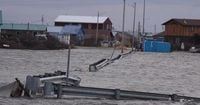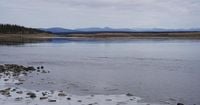Western Alaska, a region known for its remote coastal villages and rugged landscapes, was battered over the weekend by the remnants of Typhoon Halong, leaving a trail of destruction, ongoing search and rescue operations, and a community grappling with the aftermath of one of the most severe storms in recent memory. The storm, which originated as a tropical disturbance in the Philippine Sea on October 5 before strengthening to a Category 3 typhoon and passing near Japan, made its final, devastating impact on the western edge of the United States on October 12 and 13, 2025.
According to the Associated Press, hurricane-force winds and catastrophic flooding slammed into the villages of Kipnuk and Kwigillingok, pushing entire homes off their foundations and prompting urgent rescue efforts. Jeremy Zidek, spokesperson for the Alaska Division of Homeland Security and Emergency Management, described the situation as dire: “We have received reports that people’s homes have floated away and that people were potentially in those homes.”
By Sunday evening, Alaska State Troopers confirmed that at least 18 people had been rescued in Kwigillingok and 16 in Kipnuk. However, the situation remained fluid and dangerous; as of 6:50 p.m. local time, three people were still unaccounted for in Kwigillingok, and reports of missing residents in Kipnuk were still being verified. The troopers emphasized, “Search efforts will be continuing overnight as conditions allow. This is an active and ongoing search and rescue effort.”
The rescue operations have been a coordinated effort involving the Alaska State Troopers, Alaska Air National Guard, Alaska Army National Guard, and the U.S. Coast Guard. More than a dozen agencies have mobilized, with the Alaska Organized Militia activating up to 60 members to support storm response across the affected communities, as reported by CBS Fairbanks affiliate KXDF-TV. C-130 planes and Blackhawk helicopters were deployed to reach the inundated villages, which are among the most isolated in the United States and have limited infrastructure.
Governor Mike Dunleavy, in a statement quoted by multiple outlets, reassured residents that “every effort will be made to help those hit by this storm. Help is on the way.” Dunleavy expanded the state’s disaster declaration to include all areas impacted by Typhoon Halong’s remnants, building on an earlier declaration issued for another powerful storm just days prior.
The human toll has been sobering. NBC News confirmed that one woman died in Kwigillingok, while two people remain unaccounted for there. In total, more than 50 people and two dogs were rescued from Kipnuk and Kwigillingok, according to the Alaska Department of Public Safety. Amy Hendricks, a program manager for the Association of Village Council Presidents, noted that some residents suffered injuries from flying debris.
The physical destruction is staggering. State Troopers reported that at least eight homes were pushed from their foundations, with Zidek specifying that seven homes in Kipnuk and four in Kwigillingok were swept away. Nearly 600 people in Kipnuk sought refuge in a local school, while around 300 sheltered in Kwigillingok’s school, according to the nonprofit Coastal Villages Region Fund. Roads and boardwalks were submerged, and power lines were downed in Bethel, Napaskiak, Napakiak, and other communities along the Yukon-Kuskokwim Delta. The airport runway in Bethel, serving as the main staging ground for rescue operations, was littered with debris and required urgent clearing by crews.
“They are some of the most remote communities in the United States,” Zidek explained to The New York Times. With populations under 500 and no roads connecting them to the outside world, residents rely on boardwalks, boats, and snowmobiles for transportation. The region’s vulnerability was laid bare as the storm brought winds reaching up to 80 mph (with Kipnuk recording gusts of 79 mph, according to the National Weather Service in Anchorage) and water levels rising as high as seven feet above normal. Meteorologist Joshua Ribail explained that the extreme weather was the result of above-average sea temperatures near Japan interacting with colder air from Siberia, creating the perfect conditions for a powerful, hybrid storm.
Vivian Korthuis, chief executive of the Association of Village Council Presidents, highlighted the scale of the challenge: the region is home to roughly 30,000 people across 48 villages and 56 tribes. Bethel, about 100 miles northeast of the hardest-hit villages, has served as the command center for emergency operations. Korthuis also warned that severe storms are becoming more frequent, stating, “The remnants of the typhoons have been the exception, but now they are becoming the norm.” She called for more public safety facilities and trained officers capable of conducting search-and-rescue operations in these increasingly vulnerable communities.
The aftermath has left many families homeless and entire communities cut off from basic services. The National Guard and other responders have been working tirelessly to provide food, shelter, and medical care to those displaced. Flood advisories remain in effect, and another storm system was forecast to arrive by Tuesday night, raising fears of renewed flooding in Kwigillingok and nearby Kongiganak.
The devastation in Alaska unfolded as other parts of the United States faced their own weather emergencies. On the East Coast, a nor’easter brought flooding and dangerous surf to the Jersey Shore and Cape Cod, prompting Coast Guard rescues and widespread power outages. In Southern California, evacuation warnings were issued due to the risk of flooding from recent wildfires’ burn scars. But for many in western Alaska, the destruction wrought by Typhoon Halong’s remnants has been especially acute, underscoring the unique challenges faced by remote Arctic communities.
Despite the chaos, stories of resilience and community spirit have emerged. Nearly 900 people found safety in schools turned emergency shelters, and local volunteers joined forces with state and federal agencies to help neighbors in need. As the waters recede and the winds die down, the focus will shift to recovery and rebuilding—no small feat for villages perched on the edge of the Bering Sea, where infrastructure is fragile and resources are scarce.
For now, the search for the missing continues, and the full extent of Typhoon Halong’s impact is still being assessed. But one thing is clear: the people of western Alaska, with help from across the state and nation, are determined to weather the storm—no matter how fierce.


